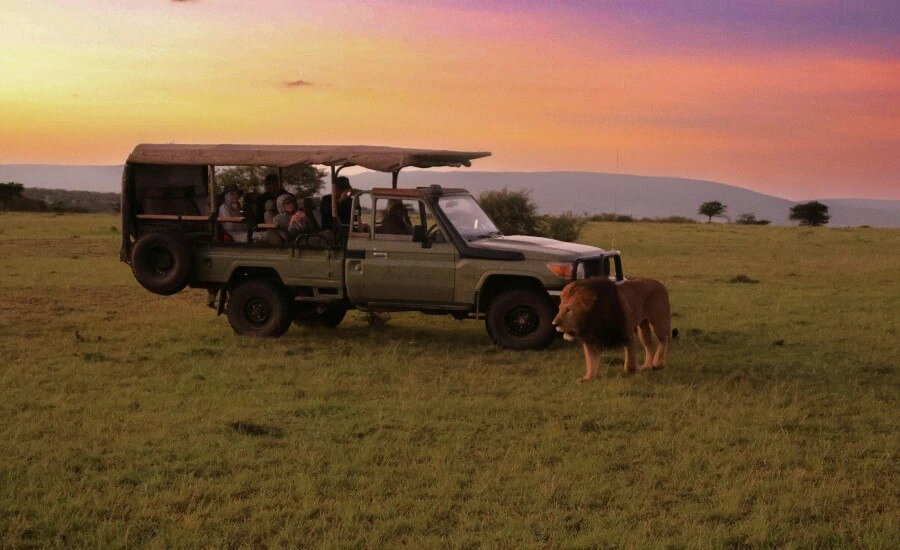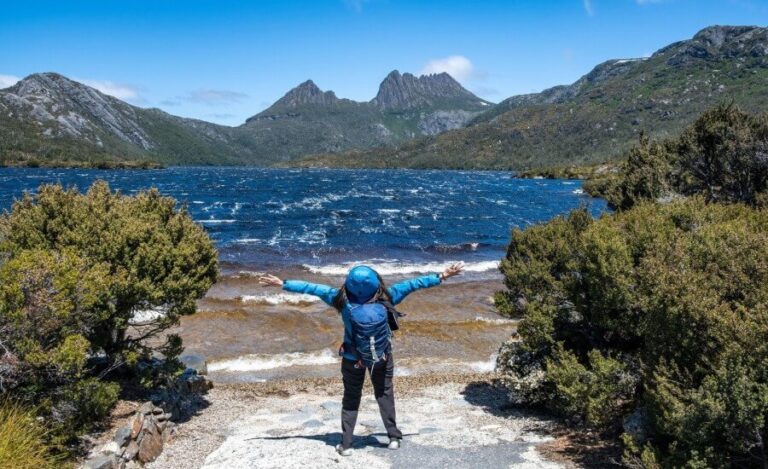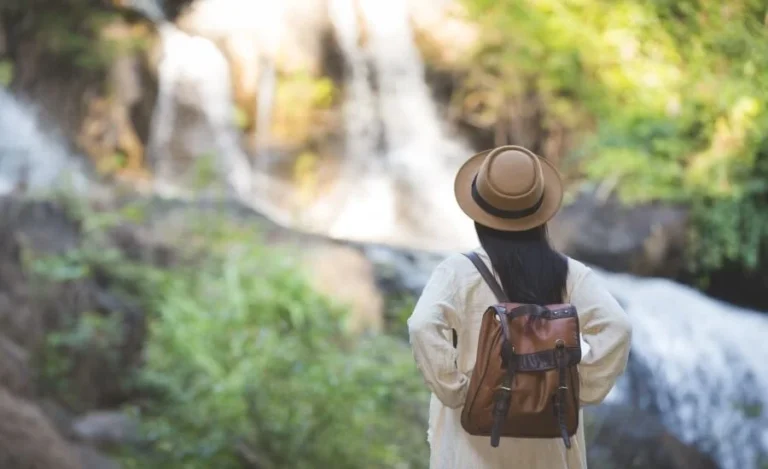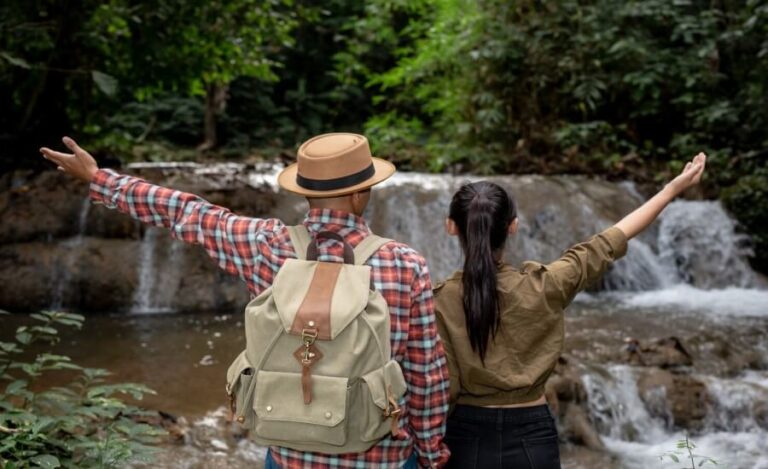
The Land Rover rumbles to a stop as the guide raises his hand. In the golden light of dawn, a family of giraffes emerges from the acacia trees, moving with silent grace across the savanna. The travelers sit in breathless silence, not a camera or smartphone in sight.
No one rushes to post this moment on social media or check if they’ve captured the perfect shot. Instead, they’re fully immersed in the experience – the distinctive pattern of each giraffe, the soft sound of leaves being plucked from branches, the warm breeze carrying scents of wild sage and dust.
This unforgettable wildlife encounter isn’t happening at a $1,000-per-night luxury lodge. These travelers are experiencing an authentic, budget-friendly safari where the focus is on connection rather than convenience, presence rather than posting, and wildlife rather than Wi-Fi.
The common perception that safaris are exclusively luxury experiences reserved for the wealthy has prevented many passionate wildlife enthusiasts from experiencing the magic of seeing animals in their natural habitat. The truth is far more accessible: with thoughtful planning, flexible expectations, and a willingness to disconnect from technology, truly remarkable safari experiences are available at a fraction of the premium price.
In this guide, you’ll discover how to plan and experience an affordable safari that emphasizes authentic wildlife encounters over luxury amenities. You’ll learn how disconnecting from digital devices can not only reduce costs but also dramatically enhance your safari experience, allowing you to form deeper connections with wildlife, local communities, and fellow travelers.
From self-drive adventures in Southern Africa to community-based wildlife tourism in Asia, these budget-friendly options deliver the essence of what makes safaris special without the prohibitive price tag.
Understanding Safari Costs: Where Your Money Goes
Before exploring budget alternatives, it’s important to understand what drives the high costs of traditional safaris. When you book a premium safari experience, your money typically goes toward:
Luxury Accommodations
High-end lodges with features like infinity pools, air conditioning, and gourmet restaurants represent the largest portion of safari costs. These properties offer undeniable comfort but often create a bubble that separates travelers from the natural environment they’ve come to experience.
Without constant Wi-Fi and electricity, budget accommodations like simple camps or community-run guesthouses naturally encourage disconnection from technology. Many travelers report that these more basic accommodations actually enhance their safari experience by removing barriers between themselves and the wilderness.
Private Vehicles and Exclusive Access
Premium safaris offer private vehicles with just your travel party, allowing complete control over your itinerary. While convenient, this luxury multiplies transportation costs significantly.
Shared game drives or public park transportation not only reduce expenses but often enrich the experience through diverse perspectives and shared excitement when wildlife is spotted. Conversation with fellow travelers replaces screen time, creating memorable human connections alongside wildlife encounters.
Professional Guides and Staff
Highly trained guides with decades of experience command premium salaries, their expertise reflected in higher tour prices. While exceptional guides can transform a safari, many parks and reserves have well-trained local guides available at more modest rates.
These local guides often possess generational knowledge passed down through families living alongside wildlife. Their perspective offers insights no amount of formal training can provide – indigenous tracking methods, traditional ecological knowledge, and cultural context that deepens your understanding of wildlife interactions.
Marketing and Luxury Branding
The “luxury safari” image is carefully cultivated through sophisticated marketing, with these costs ultimately passed to travelers. Instagram-perfect settings designed for social media sharing drive up prices while ironically disconnecting guests from authentic experiences.
Budget operators focus less on photogenic luxuries and more on fundamental wildlife experiences, often resulting in more genuine encounters and memorable stories that don’t require digital documentation to validate.
Key Points:
- Luxury accommodations typically represent 60-70% of premium safari costs
- Shared transportation can reduce safari expenses by 40-50%
- Local guides often charge 30-40% less than internationally renowned guides
- Basic accommodations naturally encourage digital disconnection
- The most memorable wildlife encounters rarely correlate with the price paid
Top 10 Budget-Friendly Safari Destinations for the Unplugged Traveler
1. Kruger National Park, South Africa: Self-Drive Adventures
South Africa’s flagship national park offers perhaps the world’s best infrastructure for self-guided, budget-friendly safari experiences. With well-maintained roads, affordable rest camps, and abundant wildlife, Kruger exemplifies accessible wilderness adventure.
The self-drive model eliminates expensive guide and vehicle fees while providing complete control over your experience. Park accommodations range from basic camping (approximately $20-30 per night) to simple bungalows with kitchenettes ($60-100 per night), all strategically located near waterholes and wildlife corridors.
What makes Kruger ideal for unplugged travel is its limited cell coverage and intentional restrictions on technology. Many camps have no Wi-Fi, with electricity available only during certain hours. This creates natural technology breaks and encourages a return to analog safari traditions: scanning horizons rather than screens, recording sightings in physical journals, and gathering around campfires to share the day’s wildlife encounters.
The park’s excellent guidebooks and detailed maps eliminate the need for digital navigation, while its self-catering facilities reduce food costs substantially. Each camp’s communal bulletin board serves as a low-tech information exchange where visitors share recent sightings, creating an organic community of wildlife enthusiasts.
Budget Breakdown:
- Park entrance: $25 per person per day
- Camping: $25-30 per night
- Basic bungalow: $60-100 per night
- Rental car: $30-50 per day
- Self-catering food: $15-20 per person per day
- Total cost for 5-day safari: $475-650 per person
Unplugged Traveler Testimony: “The limited electricity forced us to adapt to natural rhythms – waking at sunrise, wildlife watching during peak hours, and early nights under incredible stars. After the second day without checking emails, I noticed subtle behaviors in elephant herds that I had missed entirely on previous, more connected safaris.” – Michael, 42
2. Chitwan National Park, Nepal: Community-Based Wildlife Tourism
While African safaris dominate the popular imagination, Nepal’s Chitwan National Park offers an exceptional budget alternative with opportunities to see Bengal tigers, one-horned rhinoceros, and wild elephants. The park pioneered community-based tourism, where local villages directly benefit from and participate in wildlife conservation.
Staying in family-run guesthouses in buffer zone communities costs a fraction of luxury lodges ($15-40 per night) while providing authentic cultural exchange. These simple accommodations rarely have reliable Wi-Fi or constant electricity, creating a natural environment for digital disconnection.
Wildlife experiences include walking safaris with community naturalists, canoe trips along crocodile-inhabited rivers, and jeep excursions into core park areas. The multi-modal approach offers varied perspectives on wildlife impossible from the confines of a vehicle.
The absence of technological distractions enhances wildlife spotting success, particularly with elusive species like tigers. Guides consistently report that guests unburdened by cameras and phones develop superior observation skills, often spotting camouflaged wildlife before the guides themselves.
Evening activities center around community cultural performances, traditional meals prepared by local families, and informal conservation discussions rather than digital entertainment. Many visitors report these human connections become as significant as wildlife sightings in their overall experience.
Budget Breakdown:
- Park entrance: $15 per day
- Community guesthouse: $15-40 per night
- Guided walks: $10-20 per activity
- Jeep safaris: $20-30 per activity
- Meals in local homes: $5-10 per meal
- Total cost for 4-day safari: $220-380 per person
3. Etosha National Park, Namibia: Waterhole Wisdom
Namibia’s crown jewel, Etosha National Park, centers around a massive salt pan visible from space, with wildlife congregating at waterholes around its perimeter. This unique geography creates ideal conditions for budget safari experiences, as animals predictably visit water sources, especially during dry season.
The park’s government-run rest camps offer affordable accommodation ranging from campsites ($20-30) to basic rooms ($50-80), all positioned near productive waterholes illuminated at night. This setup allows continuous wildlife viewing without fuel costs or guide fees – simply sit at your camp’s waterhole and let animals come to you.
Etosha’s waterhole-focused wildlife viewing naturally discourages technology use. The patience required to wait for animals to appear makes phone checking disruptive, while the hushed atmosphere at active waterholes creates social pressure against digital distractions.
Self-catering facilities at all camps drastically reduce food expenses, while excellent park infrastructure makes self-driving safe and straightforward. The park’s simplified map centers around a single main road with waterhole turnoffs, eliminating navigation stress and fuel-wasting wrong turns.
The rhythm of an Etosha safari follows natural patterns rather than digital schedules: early morning and late afternoon game drives to distant waterholes, midday rest during wildlife inactivity, and evening sessions at camp waterholes. This natural structure eliminates the need for entertainment technology, replacing digital stimulation with patient observation.
Key Points:
- Positioned waterholes allow wildlife viewing without expensive guided drives
- Simple accommodations naturally limit digital distractions
- Clear park layout makes self-driving accessible for novices
- Natural wildlife patterns create structure without technology dependence
- Communal waterhole viewing builds connections with fellow travelers
4. Kinabatangan River, Borneo: Backpacker Wildlife Cruises
The Kinabatangan River in Malaysian Borneo offers one of Asia’s most accessible and affordable wildlife experiences. This narrow wildlife corridor, surrounded by palm oil plantations, concentrates an astonishing diversity of species along its banks – orangutans, proboscis monkeys, pygmy elephants, and incredible birdlife.
Budget travelers stay in simple homestays or backpacker lodges ($15-40 per night) in riverside villages, joining shared boat trips at dawn and dusk when wildlife is most active. This boat-based wildlife viewing represents exceptional value, with two-hour cruises typically costing $10-20 per person.
The river setting inherently discourages technology use – water and electronics don’t mix, humidity challenges device operation, and sudden rain showers are common. Most budget accommodations have limited electricity and connectivity, forcing a natural digital detox.
Unlike driving safaris where wildlife appears briefly before moving on, Kinabatangan boat trips often involve extended observation of primates, allowing travelers to witness complex social behaviors and feeding patterns. Without digital distractions, visitors become absorbed in subtle interactions that tell complex ecological stories.
Evening activities in riverside communities typically involve stargazing, nocturnal wildlife walks, or cultural exchange with indigenous Orang Sungai (“River People”) who have navigated these waters for generations. Their traditional ecological knowledge provides context impossible to Google, creating meaningful learning impossible through digital research alone.
Budget Breakdown:
- Homestay accommodation: $15-30 per night including meals
- Shared boat safaris: $10-20 per trip (2 trips daily)
- Guided night walks: $5-10 per person
- Transportation from Sandakan: $5-15 by public van
- Total cost for 3-day safari: $160-280 per person
Unplugged Traveler Testimony: “Without my phone, I started sketching the proboscis monkeys we observed. My guide noticed and shared traditional Orang Sungai symbols used to represent different animals in their art. This evolved into an impromptu cultural exchange that became the highlight of my trip – a connection that never would have happened if I’d been scrolling through photos.” – Leah, 27
5. Masai Mara Conservancies, Kenya: Community Camp Experience
While Kenya’s Masai Mara hosts some of Africa’s most expensive safari lodges, the surrounding community-owned conservancies offer budget alternatives that directly support indigenous Maasai landowners while providing exceptional wildlife viewing.
Budget travelers stay in simple community camps ($40-80 per night including meals) located on conservancy lands adjacent to the national reserve. These basic camps – often consisting of canvas tents with shared bathroom facilities – emphasize environmental immersion over luxury amenities.
Without electricity beyond solar basics, these camps operate on natural rhythms: early morning game drives when predators are active, midday rest in shade, and evening wildlife viewing followed by stargazing and Maasai storytelling around campfires. The absence of artificial light and sound creates opportunities to develop night vision and hearing acuity impossible in electrified environments.
Game drives on conservancy lands have significant advantages over national park experiences: strict vehicle limits prevent wildlife harassment, off-road driving allows closer observation of important behaviors, and the absence of day-trippers creates more intimate wildlife encounters.
Most importantly, these conservancy experiences directly benefit Maasai communities who have chosen wildlife conservation over other land uses. Cultural exchanges with community members provide context for wildlife behaviors based on generations of close observation – knowledge inaccessible through any digital resource.
Budget Breakdown:
- Community camp accommodation: $40-80 per night with meals
- Conservancy fees: $15-30 per day
- Shared game drives: $30-50 per drive
- Cultural village visit: $10-20 per person
- Total cost for 4-day safari: $380-640 per person
6. Yala National Park, Sri Lanka: Public Transport Safari

Sri Lanka’s premier wildlife destination, Yala National Park, offers exceptional leopard viewing alongside elephants, crocodiles, and diverse birdlife. What makes Yala uniquely budget-friendly is its accessibility via public transportation and the availability of simple guesthouses in gateway communities.
Budget travelers stay in family-run accommodations in Tissamaharama ($15-40 per night), arranging shared jeep safaris with other travelers to distribute the park entry and vehicle costs. Morning safari groups typically form organically in guesthouse common areas the evening before, creating natural opportunities for connection with fellow wildlife enthusiasts.
The communal nature of these arrangements encourages digital disconnection – coordinating with new acquaintances happens through face-to-face conversation rather than messaging apps, while shared wildlife interests replace social media as the primary social currency.
While luxury lodges emphasize guaranteed sightings of “flagship” species, budget safaris in Yala foster appreciation for the interconnected ecosystem. Guides working with budget travelers typically provide deeper ecological context, explaining how various species interact rather than simply checking boxes of expected sightings.
Evening activities center around comparing sighting notes with other travelers, planning the next day’s adventures, and enjoying simple Sri Lankan meals in local restaurants. This organic community building replaces the isolation of luxury electronic entertainment, creating lasting connections around shared wildlife experiences.
Key Points:
- Gateway towns provide affordable accommodation alternatives to park lodges
- Shared transportation significantly reduces per-person costs
- Public buses make the park accessible without private transportation
- Communal safari arrangements create natural opportunities for connection
- Local guides often provide deeper ecological context than premium operators
7. Cuyabeno Wildlife Reserve, Ecuador: Amazon on a Budget
The Amazon rainforest evokes images of expensive river cruises, but Ecuador’s Cuyabeno Wildlife Reserve offers immersive jungle experiences at backpacker-friendly prices. This flooded forest ecosystem hosts pink river dolphins, multiple monkey species, sloths, caimans, and extraordinary birdlife.
Budget travelers stay in basic jungle lodges ($30-60 per night including meals and activities) constructed in harmony with the environment – often using solar power, rainwater collection, and natural ventilation rather than energy-intensive technologies. These limitations create a natural environment for digital disconnection.
The humid rainforest environment poses natural challenges for electronics, with moisture and limited electricity making technology use difficult. This encourages travelers to engage their senses directly: listening for distinctive monkey calls, scanning canopy layers for movement, and distinguishing subtle scents that indicate animal presence.
Activities typically include canoe excursions, night walks to spot nocturnal species, swimming with river dolphins, and visits to indigenous communities. The intimate scale of these experiences – typically in groups of 4-8 travelers – encourages mindfulness impossible in larger, more technology-focused groups.
The immersive nature of rainforest experiences makes digital documentation particularly intrusive – camera flashes disturb nocturnal animals, phone sounds mask important wildlife cues, and screens destroy night vision essential for spotting elusive species. Most budget lodges establish technology protocols that naturally enhance wildlife viewing success.
Budget Breakdown:
- Lodge package including accommodation, meals, activities and transportation from Lago Agrio: $200-300 for 3 days/2 nights
- Bus from Quito to Lago Agrio: $10-15 each way
- Optional indigenous community visit: $10-20 per person
- Total cost for 3-day safari: $230-350 per person
Unplugged Traveler Testimony: “After my phone died on day one, I borrowed the lodge’s field guides and started identifying birds by sight and sound. By the third day, I could recognize several species by their calls alone. Our guide was so impressed he invited me to join an early morning birdwatching session normally reserved for researchers. That never would have happened if I’d been relying on bird ID apps.” – Thomas, 36
8. Okavango Delta, Botswana: Mokoro Budget Adventures

Botswana’s Okavango Delta hosts some of Africa’s most exclusive (and expensive) safari lodges, but community-run mokoro (traditional dugout canoe) trips offer a budget-friendly alternative that many travelers find more authentic and immersive than luxury experiences.
Budget travelers stay in simple delta camps ($30-70 per night) accessed via mokoro from the gateway town of Maun. These camps – often consisting of basic dome tents on wooden platforms – provide essential comforts while maintaining direct connection with the delta environment.
The water-based nature of mokoro safaris requires electronics to be carefully stowed in waterproof containers, creating natural technology breaks. Without engine noise, these silent canoe excursions allow travelers to approach wildlife without disturbance – often resulting in extraordinarily intimate encounters impossible from vehicles.
The slow pace of pole-propelled travel naturally encourages mindfulness and presence. Without the ability to quickly move between sightings (as in vehicle safaris), travelers develop appreciation for the entire ecosystem rather than focusing exclusively on “big” wildlife moments worthy of social media sharing.
Evening activities center around basic bush camps without electricity – stargazing, listening to the delta’s night sounds, and sharing stories around small fires. Guides often introduce traditional folktales that explain wildlife behaviors through indigenous perspectives, offering cultural frameworks impossible to access through digital resources.
Budget Breakdown:
- Community camp accommodation: $30-70 per night with meals
- Mokoro trips with guide: $20-40 per day
- Walking safaris: $15-30 per walk
- Transportation from Maun: $10-20 per person
- Total cost for 3-day safari: $220-380 per person
9. Udawalawe National Park, Sri Lanka: Elephant Economy Safari
While Yala attracts visitors seeking leopards, neighboring Udawalawe National Park offers extraordinary elephant encounters at budget-friendly prices. The park’s open grassland landscape provides reliable elephant viewing year-round, with herds often visible from the main road even before entering the park.
Budget travelers stay in simple guesthouses ($15-35 per night) in surrounding communities, joining shared jeep safaris that distribute entrance and vehicle costs among 4-6 passengers. Many guesthouses maintain community bulletin boards where solo travelers can connect to form safari groups, creating natural opportunities for face-to-face coordination rather than digital arrangement.
The predictable nature of elephant sightings in Udawalawe reduces the pressure common at other parks to constantly move between sightings. This creates space for extended observation of elephant behavior – watching family interactions, feeding techniques, and social dynamics that reveal the complex intelligence of these remarkable animals.
Without the distraction of phones and cameras, travelers often notice subtle communication between elephants – trunk touches, body positioning, and vocalizations that tell complex social stories. Guides consistently report that unplugged visitors ask more insightful questions and develop deeper appreciation for elephant societies.
The park’s compact size makes half-day safaris productive, allowing budget travelers to enjoy wildlife viewing without committing to expensive full-day excursions. This accessibility makes Udawalawe ideal for travelers new to safaris or those incorporating wildlife viewing into broader travel experiences.
Key Points:
- Reliable elephant sightings reduce pressure to “hunt” for wildlife
- Compact park size makes half-day safaris productive and affordable
- Gateway communities offer accommodation at fraction of lodge prices
- Open landscape allows extended observation of natural behaviors
- Community bulletin boards facilitate face-to-face connections between travelers
10. Khao Yai National Park, Thailand: DIY Asian Safari

Thailand’s oldest national park, just three hours from Bangkok, offers accessible wildlife viewing without the premium prices associated with more remote destinations. Khao Yai’s diverse ecosystems host wild elephants, gibbons, hornbills, and even occasional tigers in accessible montane forest.
What makes Khao Yai uniquely budget-friendly is its accessibility via public transportation and the availability of basic national park accommodations ($15-40 per night). These simple bungalows and campsites place travelers in the heart of wildlife habitat at a fraction of private lodge costs.
The park’s well-maintained trail system allows self-guided wildlife exploration without expensive guide fees. While guides enhance wildlife spotting success, budget travelers can alternate guided activities with independent exploration, creating a customized experience based on personal interests and budget constraints.
Evening wildlife spotting from the park’s observation towers provides excellent viewing opportunities without transportation costs. These communal spaces naturally encourage connection between travelers, with shared excitement when animals appear creating bonds impossible through digital interaction.
The park’s elevation creates cool evenings perfect for gathering around small campfires where travelers exchange sighting information and wildlife spotting tips. This organic information sharing replaces digital research, often providing more relevant, location-specific knowledge than online resources.
Budget Breakdown:
- Park entrance: $10 per person
- Basic park accommodation: $15-40 per night
- Guided night safari (shared): $15-25 per person
- Food from local markets/simple restaurants: $10-15 per day
- Public transport from Bangkok: $5-10 each way
- Total cost for 3-day safari: $150-265 per person
Disconnecting Enhances Wildlife Encounters: The Science of Unplugged Safaris
The benefits of disconnecting from technology during safari experiences go beyond philosophical arguments about “being present.” Research increasingly demonstrates that digital distraction fundamentally impairs our ability to observe, understand, and connect with wildlife in meaningful ways.
Enhanced Sensory Awareness and Wildlife Detection
Wildlife biologists have documented how digital distraction significantly reduces what they call “environmental scanning” – the continuous visual and auditory attention that allows detection of animals in complex natural environments.
A 2023 study comparing wildlife spotting success between digitally connected and unplugged safari participants found striking differences:
- Unplugged travelers detected subtle wildlife movements (like a partially hidden leopard tail) 42% more frequently
- Participants without phones identified wildlife sounds correctly 37% more often
- Groups without cameras spent 26% longer observing initial sightings before moving on
- Unplugged travelers reported noticing behavioral nuances (feeding techniques, communication gestures) at twice the rate of connected counterparts
These differences matter particularly for budget safaris, where professional guides may not always be present to point out easily missed wildlife. The enhanced observation skills developed through digital disconnection directly improve safari experiences regardless of price point.
Deeper Connection Through Undivided Attention
Conservation psychologists have documented how technological mediation creates what they term “experiential barriers” between humans and wildlife. When we view animals through cameras or immediately shift attention to documentation, we interrupt the psychological processes that create meaningful connection.
Studies of safari participants show that those who observe wildlife without technological mediation demonstrate:
- Higher emotional resonance with conservation messaging
- More accurate recall of specific behaviors and species information
- Greater reported sense of connection with observed wildlife
- Higher rates of post-safari conservation support and behavior change
For budget travelers who might experience fewer wildlife sightings than premium safari clients, maximizing the depth and quality of each encounter becomes particularly important. Digital disconnection transforms fewer sightings into more meaningful experiences.
More Authentic Community Building
Budget safaris typically involve shared transportation, communal accommodations, and group activities. The quality of these human interactions significantly impacts overall experience satisfaction, particularly when wildlife sightings are unpredictable.
Research on travel group dynamics consistently shows that digital device use disrupts the formation of temporary communities that enhance travel experiences. Unplugged safari groups demonstrate:
- More information sharing about wildlife sightings
- Higher rates of cooperative behavior (taking turns for optimal viewing)
- More equal participation in group discussions
- Deeper cross-cultural exchange with local guides and staff
- Higher reported satisfaction with overall safari experience
Key Points:
- Unplugged travelers spot subtle wildlife behaviors 42% more frequently
- Digital disconnection enhances recall of wildlife information and experiences
- Undivided attention creates deeper emotional connection to conservation issues
- Technology-free environments foster more meaningful connections with fellow travelers
- Budget travelers benefit particularly from enhanced observation skills
Common Concerns & Solutions for Budget-Friendly Unplugged Safaris
“What if I miss the perfect wildlife photo opportunity?”
-
Solution: Consider reframing wildlife encounters as experiences to be absorbed rather than captured. Research shows people who focus on experiencing rather than documenting actually form stronger, more detailed memories. If photography is important to you, designate limited “camera time” – perhaps the first five minutes of a significant sighting – then put devices away to experience the encounter directly.
-
Alternatively, many budget safari operators now offer shared DSLR cameras with telephoto lenses that participants can sign out for specific sightings, eliminating the need for everyone to carry expensive equipment. Some even provide photos of key sightings to all participants after the experience.
“How will I navigate to remote safari destinations without GPS?”
-
Solution: Budget safaris typically include transportation arrangements from major transportation hubs, eliminating navigation concerns. For self-drive safaris in places like Kruger or Etosha, excellent paper maps combined with simple park layouts make navigation straightforward without digital assistance.
-
Many budget travelers report that asking for directions creates valuable local connections and often leads to unexpected wildlife tips – “turn left at the baobab tree and check the waterhole there, we saw rhinos this morning.”
“I’m concerned about safety without constant connectivity.”
-
Solution: Legitimate safari operators maintain safety communication systems regardless of price point – typically two-way radios or satellite phones for emergency use. Budget accommodations may lack Wi-Fi but maintain basic emergency communication infrastructure.
-
Before departing, provide family members with your itinerary and the emergency contact information for your safari operator. Establish clear expectations about communication frequency and methods – perhaps a satellite text message every few days to confirm your wellbeing.
“I need to be reachable for work/family occasionally.”
-
Solution: Rather than maintaining constant connectivity, establish specific, limited “connection windows” – perhaps 30 minutes each evening when you check messages and handle truly urgent matters. Many budget safari accommodations have basic internet in common areas even when rooms lack connectivity.
-
For extending partial connectivity, consider a basic phone with long battery life rather than a smartphone. This allows essential communication while eliminating the temptation of social media and constant email checking.
“I rely on translation apps/digital guidebooks/navigation.”
-
Solution: Preparation mitigates most needs for digital resources. Before departure:
- Learn 15-20 essential phrases in local languages
- Print physical wildlife guides and regional maps
- Create a small notebook with key information (accommodation details, transport schedules)
- Consider joining guided experiences where language barriers are handled by your guide
Many travelers report that navigating these challenges analog-style creates more meaningful interactions with local communities and deeper satisfaction in problem-solving.
Before You Go: Preparation Checklist for Budget Safari Digital Detox

- Research Offline: Download or print wildlife guides, park maps, and local information before departure.
- Budget Communication Strategy: Establish how and when you’ll check in with home. Consider a basic phone rather than smartphone for occasional connectivity.
- Analog Documentation Tools: Pack a journal and sketching supplies for recording wildlife encounters and experiences.
- Physical Navigation Tools: Bring compass, paper maps, and printed directions to accommodation.
- Alternative Time Management: Invest in a reliable watch with alarm functions to replace phone timekeeping.
- Emergency Information System: Create physical cards with emergency contacts, safari operator information, and accommodation details.
- Expectation Setting: Inform friends, family, and work contacts about your limited availability, providing emergency contact protocols.
- Gradual Digital Weaning: Begin reducing screen time 2-3 weeks before departure to ease transition.
- Mental Preparation: Set intentions for your unplugged safari – what do you hope to notice, learn, or experience without technological mediation?
- Physical Preparation: Practice using binoculars, identifying common wildlife signs, and moving quietly in natural settings.
Embracing the Essence of Safari: Present, Connected, and Budget-Conscious
The original meaning of “safari” comes from the Swahili word for journey. Long before luxury lodges and Instagram feeds, safaris were about immersing in wilderness, developing awareness of natural patterns, and connecting with wildlife through patient observation. Budget safari experiences, with their natural limitations on technology and luxury, often recapture this original spirit more authentically than premium alternatives.
By choosing simpler accommodations, shared transportation, and technology-free experiences, budget travelers often discover the essence of what makes wildlife encounters transformative: full sensory engagement, undivided attention, and direct connection unmediated by screens or lenses.
The wildlife doesn’t know or care what you paid for your safari. A herd of elephants doesn’t distinguish between budget travelers and luxury guests. A leopard reveals the same breathtaking hunting skills regardless of whether you’re in a shared vehicle or private Land Rover. By focusing on the wildlife rather than amenities – and by approaching these encounters with present awareness rather than digital distraction – budget travelers often report more meaningful experiences than those who paid many times more.
As you plan your own budget-friendly safari adventure, remember that the most valuable elements of these experiences can’t be purchased at any price: patience, presence, curiosity, and wonder. By disconnecting from technology and connecting fully with the natural world, you access a form of luxury unavailable in even the most exclusive lodges – the luxury of undivided attention and complete immersion in the moment.
Wild places speak a language older than words or images. Listen with your full attention, and the conversation will stay with you long after you’ve returned home.












